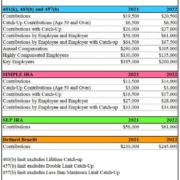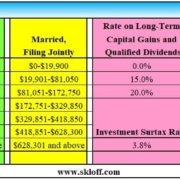How a Step-Up in Basis Can Be a Tax Dream – Part 2

Money Matters – Skloff Financial Group Question of the Month – August 1, 2024
By Aaron Skloff, AIF, CFA, MBA
Q: We read ‘How a Gift Can Be a Tax Dream or a Tax Nightmare’ Part 1 and Part 2. We also read ‘How To (Legally) Avoid Taxes When Selling Your Home’ Part 1, Part 2 and Part 3. Lastly, we read ‘How Gifting Versus Selling Your Home Can Be a Tax Dream or a Tax Nightmare’ Part 1, Part 2 and Part 3. Lastly, we read ‘How a Step-Up in Basis Can Be a Tax Dream’ Part 1. Can you give examples of the tax implications of a step-up in basis?
The Problem – A Step-Up in Basis Can Be Confusing
From income taxes to capital gains taxes to investment surtaxes in the form of the Net Investment Income Tax (NIIT), it’s no wonder the tax code is so confusing. Understanding a step-up in basis adds one more layer of confusion.
Are You Interested in Learning More?
The Solution – A Side-by-Side Comparison of Gifting, Then Selling Versus Inheriting with a Step-Up in Basis
If you and your spouse gift your home to your child and their spouse, you also gift them your cost basis (or Adjusted Basis) and your holding period, which becomes their cost basis (or Adjusted Basis) and their holding period. Upon sale, the holding period is based on the combined holding period (the amount of time you owned it plus the amount of time they owned it). In the examples below: 1. You and your spouse have a $100,000 cost basis and 2. The home does not become the primary residence of your child and child’s spouse.
Gifting Your Home to Your Child and Child’s Spouse, Then They Sell It with a Combined Ownership of 1 Year or Less
If they sell the home for $1,100,00, they would realize a $1,000,000 short term capital gains taxes ($1,100,000 selling price – $100,000 cost basis) at their 37% marginal income tax bracket, resulting in $370,000 ($1,000,000 X 37%) of income taxes plus NIIT of $38,000 ($1,000,000 X 3.8%). Their total taxes would be $408,000, leaving them with $692,000 of proceeds net of taxes – a tax nightmare. See the red (danger zone) section of the table below.
Gifting Your Home to Your Child and Child’s Spouse, Then They Sell It with a Combined Ownership of More Than 1 Year
If they sell the home for $1,100,00, they would realize a $1,000,000 long term capital gain ($1,100,000 selling price – $100,000 cost basis) at their 20% capital gains rate, resulting in $200,000 ($1,000,000 X 20%) of capital gains taxes plus NIIT of $38,000 ($1,000,000 X 3.8%). Their total taxes would be $238,000, leaving them with $862,000 of proceeds net of taxes – a tax nightmare. See the yellow (safe zone) section of the table below.
Having Your Child and Child’s Spouse Inherit Your Home, Then They Sell It Immediately
If they inherit the home, they would receive a step-up in basis to the fair market value of the home on your date of death, which is $1,100,000. If they immediately sell the home for $1,100,000, they would be exempt from taxes – a tax dream. The step-up in basis would have saved them $408,000 in taxes versus the first scenario and $238,000 versus the second scenario. See the green (ultra safe zone) section of the table below.
Click to Enlarge
Action Steps
Work closely with your Registered Investment Adviser (RIA) to reduce your taxes, and grow and preserve your wealth.
Aaron Skloff, Accredited Investment Fiduciary (AIF), Chartered Financial Analyst (CFA), Master of Business Administration (MBA) is CEO of Skloff Financial Group, a Registered Investment Advisory firm specializing in financial planning, investment management and benefits for small to middle sized companies. He can be contacted at www.skloff.com or 908-464-3060.













